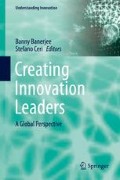Abstract
The big issues we face today are those that go to the heart of our societies, economies and environments. What is the best response to terrorism? What is the right approach to immigration to enhance society and build the economy? How can we preserve water resources while achieving economic returns from irrigated agriculture in a way that fits with the local context? These are just a few examples of the intractable challenges that we face today. These are the types of problems that C. West Churchman called “wicked problems” in his “Guest Editorial” of Management Science. Wicked problems resist resolution and have many interrelated parts such that a change in one area will affect the other parts, often in an unintended way (see also: Rittel and Webber 1973).
Access this chapter
Tax calculation will be finalised at checkout
Purchases are for personal use only
Notes
- 1.
The output of innovation can be viewed as a matrix created by a convolution of the elements of current system parameters and the elements of innovation.
- 2.
An analogy of that is a car driver who can tell the condition of the road without resorting to analytical data.
- 3.
The concept of innovation output was discussed by (Keeley et al. 2013).
- 4.
- 5.
See for example articles in the “Action Research Journal”: http://arj.sagepub.com, and http://infed.org/mobi/kurt-lewin-groups-experiential-learning-and-action-research/
References
Berkeley College of Music, ‘Rethink Music. New business model in the music industry,’ A framing paper for the ‘Rethink Music Business Models Workshop.’ April, 2013. Valencia, Palau de les Arts, Valencia, Spain.
Brin S, Page L (1998) The Anatomy of a Large-Scale Hypertextual Web Search Engine. Computer Networks and ISDN Systems 30:107–117
Churchman C (1967) West used “wicked problems” in his “Guest Editorial” of Management Science 14:141–142
Fox M, and Wrenn, B (2001) A broadcasting model for the music industry. The International Journal on Media Management, JMM 3:112–119
Graham R. (2013) Technology Innovation Ecosystem Benchmarking Study: Key findings from Phase 1’, January 2013. http://www.rhgraham.org/RHG/Recent_projects_files/Benchamrking%20study%20-%20Phase%201%20summary%20.pdf accessed November 2014.
IFPI Digital Music Report (2013) Engine of a digital world. http://www.ifpi.org/downloads/dmr2013-full-report_english.pdf accessed November 2014.
Johnasson F (2006) The Medici Effect: What Elephants and Epidemics Can Teach Us About Innovation. Harvard Business School Press. Harvard Way, Boston, Massachusetts.
Keeley L, Pikkel R, Quinn B and Walters H. (2013) Ten Types of Innovation. John Wiley & Sons, Inc., Hoboken, New Jersey.
Kemp R, and Pearson P (2007) Final report MEI project about measuring eco-innovation. UM Merit, Maastricht 10.
Kesidou E, Pelin D (2012) On the drivers of eco-innovations: Empirical evidence from the UK. Research Policy 41:862–870
Leonard DA., and Straus S (1997) Putting Your Company’s Whole Brain to Work. Harvard Business Review 75, no. 4 (July–August 1997): 110–122
Leurdijk A, de Munck S, van den Broek T, van der Plas A, Manshanden W and Rietveld E (2012) Statistical, Ecosystems and Competitiveness Analysis of the Media and Content Industries. Jean Paul Simon ed., European Commission, Joint Research Centre; Institute for Prospective Technological Studies. http://ftp.jrc.es/EURdoc/JRC69435.pdf
PricewaterhouseCoopers ‘Global Entertainment and Media Outlook’ in http://www.pwc.com/gx/en/global-entertainment-media-outlook/, accessed in November 2014.
Scholes R (2000) Uniquely GoogleTM, Stanford Technology e-Brainstorm. The Newsletter of Stanford’s Office of Technology Licensing (OTL).
Reshef DN et. al. Detecting Novel Associations in Large Data Sets, Science 334, 1518 (2011).
Rittel H, Webber M (1973) Dilemmas in a general theory of planning. Policy Sciences 4:155–169
Russell MG, Still K, Huhtamäki J, Yu C and Rubens N (2011) Transforming Innovation Ecosystems Through Shared Vision and Network Orchestration’ in Triple Helix 9 – Innovation Ecosystems Summit 2011 – Stanford University.
Vise D and Malseed M (2005) Google Story Inside the Hottest Business, Media and Technology Success of Our Time in ‘The Google Story’, Bantam Dell Publishing, NY.
Author information
Authors and Affiliations
Corresponding author
Editor information
Editors and Affiliations
Rights and permissions
Copyright information
© 2016 Springer International Publishing Switzerland
About this chapter
Cite this chapter
Body, J., Habbal, F. (2016). The Innovation Ecosystem. In: Banerjee, B., Ceri, S. (eds) Creating Innovation Leaders. Understanding Innovation. Springer, Cham. https://doi.org/10.1007/978-3-319-20520-5_2
Download citation
DOI: https://doi.org/10.1007/978-3-319-20520-5_2
Publisher Name: Springer, Cham
Print ISBN: 978-3-319-20519-9
Online ISBN: 978-3-319-20520-5
eBook Packages: Business and ManagementBusiness and Management (R0)

